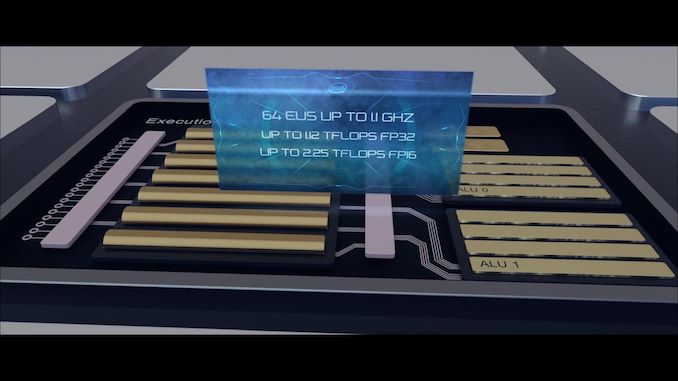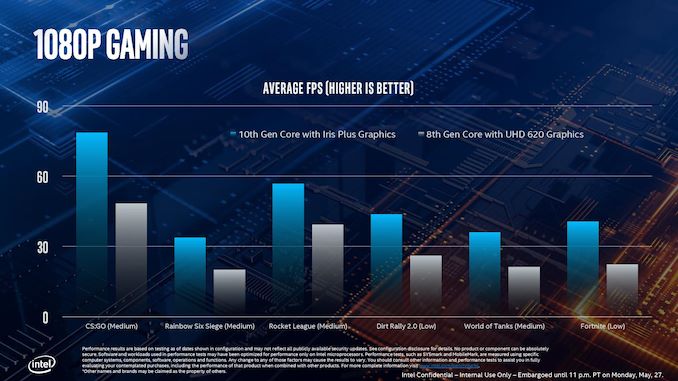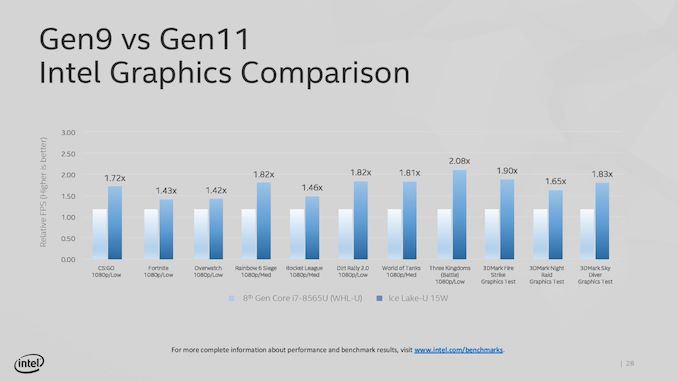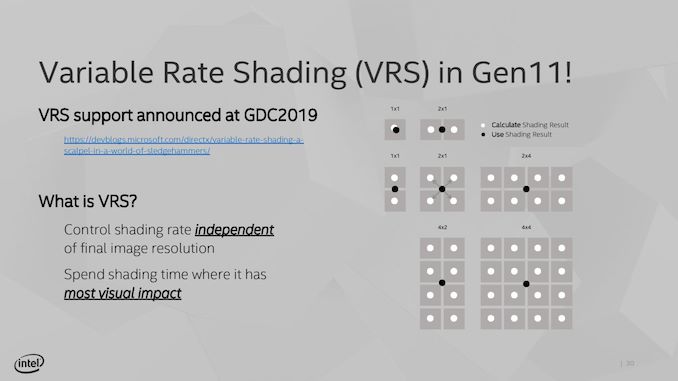Examining Intel's Ice Lake Processors: Taking a Bite of the Sunny Cove Microarchitecture
by Dr. Ian Cutress on July 30, 2019 9:30 AM EST- Posted in
- CPUs
- Intel
- 10nm
- Microarchitecture
- Ice Lake
- Project Athena
- Sunny Cove
- Gen11
Gen11 Graphics: Competing for 1080p Gaming
The new message from Intel is that it is driving to deliver deep gaming experiences with its technology, and the nod to the future is specifically what it wants to do with its graphics technology. Until the company is ready with its Xe designs for 2020 and beyond, it wants to start to lead the way with better integrated designs. That starts with Ice Lake, where the most powerful version of Ice Lake will offer over 1TF of compute performance, support higher resolution HEVC, better display pipes, an enhanced rasterizer, and support for Adaptive Sync.
The key words in that last sentence were ‘the most powerful version’. Because Intel hasn’t really spoken about its product stack yet, the company has been leading with its most powerful Iris Plus designs. We assume this means 28W? That means its high-end performance products, in the best designs, with the fastest memory. Compared to the standard Gen9 implementation of 24 execution units at 1150 MHz turbo, the best Ice Lake Gen11 design will deliver 64 execution units up to a 1100 MHz frequency, good for 1.15 TF of FP32 performance, or 2.30 TF of FP16 performance. Intel promise up to 1.8x better frame rates in games with the best Ice Lake compared to an average 8th Gen Core (Kaby Lake) Gen9 implementation. Intel doesn’t compare the results to a hypothetical Cannon Lake Gen10 implementation.
Intel hasn’t stated how many graphics configurations it will offer, but there would appear to be several given what information has leaked out already. The high-end design with 64 execution units will be called Iris Plus, but there will be a ‘UHD’ version for mid-range and low-end parts, however Intel has not stated how many execution units these parts will have. We suspect that standard dividers will be in play, with 24/32/48 EU designs possible as different parts of the GPU are fused off. There may be some potential for increased frequency in these designs, reducing latency, but ultimately reduced performance over the top design.
It should be noted that Intel is promoting the top model as being suitable for 1080p low-to-mid gaming, which would imply that models with fewer execution units may struggle to hit those highs with different EU counts. Until Intel gives us a full and proper product list, it is hard to tell at this point.
This slide, for example, shows where Intel expects its highest Ice Lake implementation to perform compared to the standard 8th Gen solution. As part of Computex, Intel also showed off some different data:
This graph shows relative FPS, rather than actual FPS, so it’s hard to see if certain games are just hitting 30 FPS in the highest mode. The results here are a function of the combination of increased EU count but also memory bandwidth.
Features for All
There are a number of features that all of the Gen11 graphics implementations will get, regardless of its number of execution units.
For its fixed function units, Gen11 supports two HEVC 10-bit encode pipelines, either two 4K60 4:4:4 streams simultaneously or one 8K30 4:2:2 stream using both pipelines at once. On display pipes, Gen11 has access to three 4K pipes split between DP1.4 HBR3 and HDMI 2.0b. There is also support for 2x 5K60 or 1x 4K120 with a 10-bit color depth.
The rasterizer gets an upgrade, and will now do 16 pixels per clock or 32 bilinear filtered texels per clock. Intel also gives some insight into the cache arrangements, with the execution units having their own 3 MiB of L3 cache and 0.5 MiB of shared local memory.
Intel recommends that to get the best out of the graphics, it should be paired with LPDDR4X-3733 memory in order to extract a healthy 50-60 GB/s bandwidth, and we should expect a number of Project Athena approved designs do just that. However, at the lower end of Ice Lake devices, we might see single channel DDR4 designs take over due to costs, which might limit performance. As always for integrated graphics, memory bandwidth is often a major bottleneck in performance. Back when Intel had eDRAM enabled Crystalwell designs, those chips were good for 50 GB/s bidirectional bandwidth, and we are almost at that stage with DRAM bandwidth designs now. It should be noted that there are tradeoffs with memory support: LPDDR4/X supports 4x 32b channels up to 32 GB with super low power consumption modes, but if users want more capacity, they’ll have to look to DDR4-3200 with 2x 64b channels up to 64 GB, but lose some performance and power savings.
Variable Rate Shading
A feature being implemented in Gen11 is Variable Rate Shading. VRS is a game-dependent technology that allows the GPU adjust the shading performance of the scene render based on what areas are important. All games currently do shading on a per-pixel basis, meaning that each pixel has a full calculation and that data is transferred to the final image. With VRS, shading is calculated over several pixels at once – essentially doing pixel shading in a coarser, lower-resolution manner – to save post-processing time by using averaged data.
The idea is that using this method can reduce some of the load on the execution units, ultimately increasing the frame rate. The size of that combination of pixels can be adjusted on a per-frame basis as well, allowing the game to take advantage of processing budget where it exists, or pull back to a point where performance is needed. Ultimately Intel believes that any image quality loss is not noticeable, especially for the performance impact they expect it to provide. Intel states that this technology is useful for areas such as lighting adjustments, partially obscured objects (by fog/clouds), and areas that undergo blur, or foveated rendering – basically any area where clarity isn’t explicitly required to begin with.
The only issue here though is an ecosystem one – it requires the game developer support. Intel is already working with Epic to add it to the Unreal Engine, and Intel has worked with developers to enable support in titles such as Civilization 6. The difference in performance, according to Intel, can be up to a 30% FPS increase in a best-case scenario. NVIDIA already supports VRS through dedicated hardware, whereas AMD’s current solutions are best described as a more limited shader-based approximation.














107 Comments
View All Comments
s.yu - Thursday, August 1, 2019 - link
"Charge 4+hrs in 30 mins"...Ok, I think "4+hrs battery life under 30 min. charging" sounds better, or just Intel's version.
29a - Thursday, August 1, 2019 - link
Should Intel go ahead with the naming scheme, it is going to offer a cluster of mixed messages.I believe the word you are looking for there is clusterfuck.
ifThenError - Friday, August 2, 2019 - link
To bad the article doesn't state any further details about the HEVC encoders. Would be interesting to hear if Intel only improved the speed or if they also worked on compression and quality.I bought a Gemini Lake system last year to try the encoding in hardware and have very mixed feelings about Intel's Quick Sync since. The encoding speed is impressive with the last generation already, and all the while CPU and GPU are practically in idle. On the downside the image quality and compression ratio is highly underwhelming and not even near usable for “content creation“ or mere transcoding. It suffices for video calls at best. Even encoding h264 in software reaches far better compression efficiency while being not much slower on a low end CPU.
IIRC Intel promised some “quality mode” for their upcoming encoders, but I can't remember if that was for the gen11 graphics.
intel_gene - Friday, August 2, 2019 - link
There is some information on GNA available. It is accessed through Intel's OpenVINO.https://docs.openvinotoolkit.org/latest/_docs_IE_D...
https://github.com/opencv/dldt/tree/2019/inference...
There is some background information here:
https://sigport.org/sites/default/files/docs/Poste...
urbanman2004 - Friday, August 2, 2019 - link
I wonder what happens to Project Athena if none of the products released by the vendor partners/OEMs meet the criteria that Intel's established.GreenReaper - Saturday, August 3, 2019 - link
Plagues of snakes, owls, eagles, Asari, etc.gambita - Monday, August 5, 2019 - link
nice of you to do intels bidding and promote and help their prhowtomakedeliciousfood - Thursday, August 8, 2019 - link
www.howtomakedeliciousfood.comHikariWS - Sunday, August 11, 2019 - link
These improvements on serial performance are great, it's awesome to have bigger buffers and more execution units. But in clock area it seems to be a big drawback.I'm sure clock issues is the reason we won't have any Ice Lake on desktop, and Comet Lake on laptops on the same generation. But, why no 6C Ice Lake? This opened a but alert sign on me.
But what also called my attention is its IGP power. Most mid range and above laptops ae using nVidia GPU. That's sad for us who want performance and won't play on it, because mid laptops are alrdy all coming with nVidia GPU which makes them more expensive.
Now I hope to have these segments using Intel IGP and not have nVidia GPU anymore. Good to us on having less money wasted on hardware we don't need, bad for nVidia.
nils_ - Wednesday, August 14, 2019 - link
Can you please stop eating the chips? Yield must be bad enough as it is!